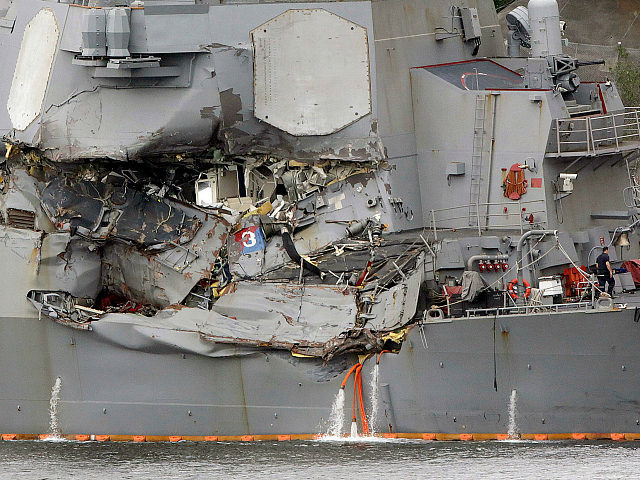The captain of a Philippine-flagged cargo ship that collided with a U.S. Navy destroyer this month in Japanese waters has claimed his ship flashed lights and tried to steer hard to the right to avoid the U.S. warship, according to a report by Reuters.
ACX Crystal Captain Ronald Advincula, in a report to Japanese ship owner Dainichi Investment Corporation seen by Reuters, said the USS Fitzgerald “suddenly” steamed onto a course to cross its path, causing the collision at about 1:30 a.m. on June 17.
Advincula also said his ship did not report the collision to the Japanese Coast Guard for almost an hour after it happened because there was “confusion” on his ship’s bridge. Reuters said it could not independently verify the captain’s account.
However, an independent analyst said this account conflicts with open source intelligence showing the Crystal’s path.
“The claim that the ACX Crystal made a hard starboard/right turn for 10 minutes before colliding with the USS Fitzgerald can be disproven by reviewing at the available [automatic identification system] data for evidence to corroborate the claim,” said Steffan Watkins, a contributor to Jane’s Intelligence Review.
“AIS transponders are there for marine safety and collision avoidance, but in this case we can use the data to retrace the moments leading up to the collision, like a trail of breadcrumbs, which include the course, speed, and exact location of the vessel,” he said.
He said instead of a hard right, the data shows the Crystal made a slight right – at the moment he believes the collision occurred.
He said the data then shows the Crystal spun around 65 degrees, from what he suspects is the Fitzgerald being stuck on the cargo ship and acting as a bow thruster.
After that, he said the data shows the Crystal correcting its course and speeding up, suggesting it was on autopilot when the collision happened and for 15 minutes afterward, until the cargo ship turned back to the scene of the collision and reported the incident almost an hour later.
“While there will clearly be enough blame to go around, the captain’s version of how it happened seems quite unbelievable based on the data that has been transmitted by the ship’s AIS transponder to shore-based receivers, and made available online by sites like http://MarineTraffic.com,” Watkins said.
Watkins also said the claim that the Crystal flashed lights it somewhat dubious, given the standard warning of an incoming ship is to blast a horn five times.
“My understanding is five blasts of the ship’s horn is the maritime warning for imminent collision; no mention of the horn was made, just flashing a light. That’s unusual, and out of the ordinary, but I can’t disprove it,” he said.
There are now six investigations into the incident, which tore a hole in the Fitzgerald’s starboard side and caused severe damage below the waterline, causing berthing spaces to flood and lead to the deaths of seven U.S. sailors in the deadliest at-sea incident for the U.S. Navy since 2000.
The U.S. Navy, the U.S. Coast Guard, the Japan Transport Safety Board, the Japanese Coast Guard, and the Philippines government are all conducting investigations into the collision.

COMMENTS
Please let us know if you're having issues with commenting.